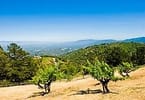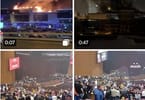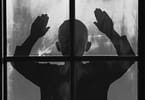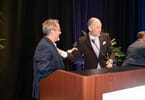An ingenious painter of historical and genre pictures, landscapes, and portraits, he banishes “critical realism” in oil on canvas.
In his works, he boldly tries to be as close to the truth as possible. His paintings are testimonials of his own combat experiences in Central Asia. His attempts to display the horrors of war and devastation turn his paintings into genuine image essays, catching both the moment and the spirit – not the one of “swagger and military bravado” as he himself says, but the spirit of the heroic people who suffer most in times of war “and of the barbarous brutality of rulers who plunge nations into bloody holocausts.”
Facing the daily news about death and destruction in war-torn Ukraine, we may figure out the described painter to be a contemporary witness of a series of conflicts and wars, starting from Afghanistan via the Middle East and North Africa, up to the Caucasus and – since 2014 – Ukraine. However, although he is not a coeval – in terms of the arousing message of his paintings, he definitely is!
His name is Vasily Vereshchagin. He was born on October 26, 1842, in Cherepovets/Novgorod Governorate, Russia, and died on April 13, 1904. In excess of his capabilities as an amazing painter of realism, he excelled as a historian, ethnologist and geographer, a writer and journalist, and, particularly, a passionate traveler, covering inter alias the Balkans, the Middle East, Turkestan, Manchuria, India, the Philippines, Japan, Cuba, and the United States.
In the second half of his lifetime, Vereshchagin held 65 exhibitions of his works, mostly in Western Europe and the United States.
Public feedback was overwhelming.
Why actually did people appreciate so much Vereshchagin? In the illustrated book “Vereshchagin,” published in 1987 at “Leningrad Khudozhnik RSFSR,” Andrei Lebedev and Alexander Solodnikov provide remarkable insights on free expression in the wake of Gorbachev’s Glasnost and Perestroika: “What attracted people in Vereshchagin’s paintings and made him world famous was, first and foremost, the ideas of liberty and democracy which were the motto of Russian intelligentsia of the nineteenth century and became the source of inspiration for Vereshchagin.”
Although he lived in the 19th century, the war-theme of many of his 235 artworks have lost nothing of their properties of remembrance and cathartic warning: They are appalling, galvanizing us all the more than we have gotten aware of the unthinkable: that war has returned to Europe, up to the point of rattling the rusty locks of ABC Cold War arsenals.
Vereshchagin was some 25 when he was fully involved in what was called “The Great Game,” describing the 19th century rivalry between Russia, Great Britain, and China in Central Asia. He witnessed indiscriminate bloodshed in the battles between the Russian army and the soldiers of the Buchara Emirate. In the Russo-Turkish War over the liberation of the Balkans from Ottoman oppression, Vereshchagin was severely wounded. In his paintings he condemned “some of the Russian commanders’ incompetence and lack of devotion” (from “Vereshchagin” by Lebedev and Solodnikov).”
Having become a “Partisan of Peace,” he could not but strongly condemn nationalism or chauvinism.
Nothing to say that brass hats of the military felt parts of Vereshchagin’s paintings most outrageous, emanating serious problems for the artist. He had dedicated his paintings to brandish the horrors of war, albeit his own death was not peaceful. Vereshchagin jointly with his host, Admiral Stepan Markarov, perished onboard the Russian flagship “Petropavlovsk,” which was struck by two mines while returning to Port Arthur (today Dalian/China) and sank on April 13, 1904, during the Russo-Japanese War (Russia, though regarded as superior, lost that war, thus nurturing first doubts on “European” invincibility in Asia).
Alas, Vereshchagin would have preferred to use his talents showing the bright sides of life. His lifestyle was anything but sedentary, after all, and he would share with others his predilection of traveling the world with a strong inclination to adventurism. “I loved the sun all my life and wanted to paint sunshine,” Vereshchagin wrote, “when I happened to see warfare and say what I thought about it, I rejoiced that I would be able to devote myself to the sun once again. But the fury of war continued to pursue me” (from Vasily Vereshchagin – Wikipedia).”
Austrian-Bohemian pacifist and novelist Bertha von Suttner got to know Vereshchagin. In her memoirs she remembered a visit to one of his exhibitions in Vienna, “At many of the paintings we could not suppress a cry of horror.” Vereshchagin answered: “Perhaps you believe that is exaggerated? No, the reality is much more terrible (from peaceinstitute.com). ”
The last painting of Vereshchagin’s series “The Barbarians,” bears the title “Apotheosis of War” – a grim illustration of a pyramid of human skulls. He understood his canvas as a kind of synthesis of the terrible raids the Oriental despot Tamerlane once executed upon Central Asia and beyond. Vereshchagin’s message is highly political, “To all great conquerors – past, present and future.” Seeming parallels with today’s war in Ukraine could not be more evocative.
Although Leo Tolstoy’s masterpiece “War and Peace” incited Vereshchagin to visualize Tolstoy’s literary anti-war stance in oil on canvas, it was Tolstoy’s novel “Resurrection” that beat all records when it was published in 1899. Sequences of the novel appeared a year later in the American monthly magazine, “Cosmopolitan,” with the title translated very freely into “The Awakening.” Today it’s the awakening to find the exit to peace!
Our “Happy Easter” wishes may sound more sincere today. Yet they may sound inadequate if addressed to people suffering from war and deprivation. For them being “happy” has turned into a farce. Yet there is still Easter, and consolation, and encouragement sound in the words of the Eastern Church: “Christos voskrese/Christ is risen.” “Voistinu voskrese/He is risen, indeed.”
IHE Ị GA-Ewepụ na edemede a:
- In excess of his capabilities as an amazing painter of realism, he excelled as a historian, ethnologist and geographer, a writer and journalist, and, particularly, a passionate traveler, covering inter alias the Balkans, the Middle East, Turkestan, Manchuria, India, the Philippines, Japan, Cuba, and the United States.
- Facing the daily news about death and destruction in war-torn Ukraine, we may figure out the described painter to be a contemporary witness of a series of conflicts and wars, starting from Afghanistan via the Middle East and North Africa, up to the Caucasus and – since 2014 – Ukraine.
- “What attracted people in Vereshchagin’s paintings and made him world famous was, first and foremost, the ideas of liberty and democracy which were the motto of Russian intelligentsia of the nineteenth century and became the source of inspiration for Vereshchagin.








![Ụgbọ oloko Hyperloop nke China: Nleba anya na Ọdịnihu nke Ụgbọ njem 6 Akụkọ Njem Nlegharị anya | Ụlọ & Mba Ụgbọ oloko Hyperloop China [Foto: Teknụzụ Ụgbọ njem Hyperloop]](https://eturbonews.com/cdn-cgi/image/width=145,height=100,fit=crop,quality=80,format=auto,onerror=redirect,metadata=none/wp-content/uploads/2024/02/180720163348-hyperlooptt-china-capsule.jpg)














